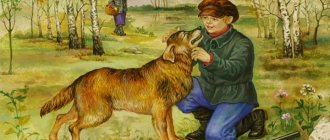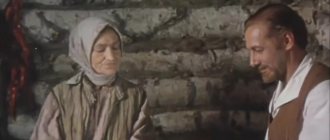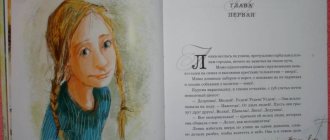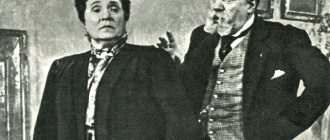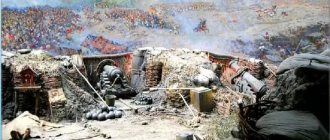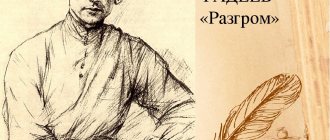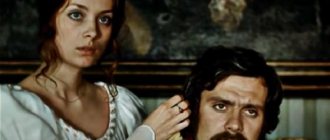“Pantry of the Sun”: summary
“The Pantry of the Sun” is a unique example of a fairy tale, the genre of which was developed by Mikhail Mikhailovich Prishvin. The work closely intertwines human destinies and nature, which does its best to help the little heroes. In fact, trees, a swamp and the sun are full-fledged characters that have a lively and interesting appearance.
The work “The Pantry of the Sun,” a brief summary of which is presented to the reader, is a story about the power of the harmonious connection between man and nature. The story is that you can overcome any adversity by acting according to your conscience and listening to your heart. The story is that man is the pinnacle of evolution, but only when he lives in harmony with everything that surrounds him.
This idea is substantiated in the story by Mikhail Mikhailovich Prishvin. “Pantry of the Sun”, a brief summary of which is presented according to the main stages of the plot, describes the following events:
Exposition
The colorful and vibrant introduction doesn't start out like a classic fairy tale. Instead of the standard “once upon a time,” the reader unfolds the story of two orphans:
- Their mother died without recovering from the disease, and their father died a heroic death on the fields of World War II.
- Nastya and Mitrasha first lived under the supervision of neighbors, and then learned to lead their own lives.
The beginning
A brief retelling of “The Pantry of the Sun” should begin from the moment the children go to the forest. Every year, at the end of the February cold, people went into the forest to pick cranberries. After lying under a warm blanket of snow, it became much sweeter and healthier. Nastya and Mitrasha also decided to go to Palestine, which their father told them about:
- the girl did not forget to grab bread, some milk and potatoes for a snack;
- Mitrash, like a real man, took with him a basket and a compass to find the right path.
The image of Mitrasha in the illustration by E. Rashchin: YouTube / MyBook
On the way, the boy told his sister about the Bludov swamp - a terrible place that had a bad reputation. Having reached a fork with a stone, the children separated and went along different paths. Nastya along the common road, and Mitrash along an unexplored path to the north.
Climax
So, “Pantry of the Sun” in short. If you describe the most important events, then you need to mention the climax of the fairy tale. The author helps the reader observe two characters:
- The dog Travka follows Nastya. Previously, the dog served the local forester, but after his death he remained to live in the forest, howling occasionally, yearning for his owner. Having smelled the food in the girl’s basket, Grass went after it. The Gray Landowner, a wild wolf living on the hill, came running to the howl of Grass;
- Mitrash wandered along the roads until he reached the swamps. By the way, it is here that the reader finds the answer to the question, what is the sun's pantry? People called this place “the pantry of the sun” because peat was stored there for years. Deciding to take a shortcut, the boy walked straight through the muddy clearing and soon found himself in a quagmire.
At this moment, the reader’s tension increases, and anxiety for the children and lack of focus only intensifies the tension.
Denouement
Nastya continued to collect cranberries and had no idea what kind of trouble her brother was in. Having called out to him a couple of times and hearing only silence in response, the girl suspected something was wrong and was very upset.
The child’s bitter tears forced Grass to go in search of the boy, and the dog’s sensitive scent led her to the swamp. Grass saw a child stuck in a quagmire, came closer to him and allowed him to grab his hind legs. Then the dog rushed with all his might and helped the child get out of the swamp trap. Mitrasha was saved.
At this time, Travka picked up the trail of the hare and chased him, and Mitrasha went after her. He understood that dusk was already falling on the forest and he and his sister needed to spend the night right here. Following the dog, the boy follows the trail of the Gray landowner and kills the dangerous predator. Nastya comes running at the sound of the shot, the guys have dinner, and in the morning they return to the village together.
The short story “The Pantry of the Sun” is a quick read. The plot of the work holds the reader’s attention, forcing him to turn page after page in order to quickly find out the ending of the work “The Pantry of the Sun”. Prishvin has said more than once that he considers this creation not just a fairy tale, but an ode to the strength of the human spirit, an ode to endurance, friendship, courage and mutual assistance.
Contents by chapter
Prishvin's fairy tale describes the life of two orphans in the post-war period. Their lives change when they go to the swamp to pick cranberries. The events that take place teach them responsibility, mutual assistance and respect for each other. To avoid having to read the entire story, a brief retelling of the work is given chapter by chapter.
First and second
In the first chapter, two children, Nastya and Mitrasha, who live in a village near the Bludov Swamp, remain orphans because their mother died of illness and their father died in the war. The guys are left alone on the farm, and at first it is very difficult for them. Thanks to the help of their neighbors, they gradually learn everything. The children live together. Nastya gets up early and spends the whole day doing chores and housework, while Mitrasha makes crafts:
- barrels;
- pelvis;
- other wooden items.
He subsequently sells all this. The second chapter begins with the fact that in the spring they go to pick cranberries in the village, because after lying all winter under the cover of snow, they become much tastier than those that can be found in the fall.
So the heroes go to pick berries in April. Mitrash equips himself thoroughly - he takes with him his late father’s gun and a compass so as not to get lost in the forest. Nastya is preparing a basket of supplies:
- milk;
- bread;
- potatoes.
In the second chapter, the guys decide to go to Blind Elani - their father told them that there is a special “Palestine” there, where there are a lot of cranberries.
Third, fourth, fifth, sixth
Early in the morning, before dawn, the children go on their journey. The third chapter shows how they walk towards the Bludov swamp. Mitrasha tells her sister that a very dangerous predator lives in these places, a lone wolf named Gray Landowner. And suddenly a howl is heard in the distance. But Mitrasha continues to boldly lead her sister along the compass, to the north.
In the fourth chapter, the children go to the Lying Stone. There are two forest paths there, but one of them is trampled by people, well-trodden, and the other is “weak,” but it leads directly to the north. The further road becomes the cause of a quarrel between brother and sister, Mitrash goes along a narrow path to the north, and Nastya goes along a well-trodden one.
The fifth chapter tells the story of the dog Travka. She lives in a potato pit, near the destroyed lodge of the late forester Antipych. It has been two years since the animal was left alone, and, yearning for its beloved owner, it often howls pitifully.
The sixth chapter begins with a story about how a few years ago a wolf hunt was announced near the Sukhaya River. The people killed everyone except the Gray landowner, who managed to escape from them. However, he lost his left ear and half of his tail. In the summer, the predator terrorized villages - killing livestock and even dogs. They tried to catch the Gray landowner five times, but he turned out to be more cunning.
Seventh, eighth, ninth and tenth
In the seventh chapter, the hungry Gray landowner hears the howl of the yearning Grass and heads in his direction. However, the dog at the same time senses the trail of the hare and moves in the direction of it. Near the Lying Stone, she also smells bread and therefore runs after Nastya.
The author describes the fornication swamp in the eighth chapter as a pantry of the sun. This is explained by the fact that peat lies at the bottom of the swamp for thousands of years, and then “is inherited by man from the sun.”
Mitrash goes towards Blind Elani - this is a terrible place where many people have already died. Gradually the ground under his feet becomes more and more unsteady. He wants to take a shortcut and takes a shortcut, going straight through the clearing. However, here the boy begins to drown in the swamp. He flounders, trying to get out, but only falls deeper and deeper into the quagmire. The only way out is to hold on to the gun. Mitrash hears Nastya calling him, and he shouts back, but the wind carries away the sounds of his voice.
In the ninth chapter, Nastya enthusiastically and intently collects cranberries and, unnoticed by herself, reaches the “Palestine” where the guys wanted to come. There are even more berries here, and Nastya is completely absorbed in collecting them, coming to her senses only when she almost touches a snake with her hand. Here she finally notices the dog Travka, who came after her. Nastya shares bread with her and remembers Mitrash. She calls him, but receives no answer, and then she cannot hold back her tears.
Chapter ten begins with Travka, being a smart dog, howling in unison with Nastya’s tears. But the Gray landowner hurries to this sound. Then the dog hears a fox hunting a hare nearby and runs to Blind Elani.
Eleventh and twelfth
In pursuit of the hare, in the eleventh chapter, Grass runs out not far from the place where Mitrasha is trying not to drown. With all his might, the boy calls the dog, it runs up, and he grabs its hind legs. She sharply tries to pull him out, and Mitrasha manages to crawl out of the quagmire. Grass happily rushes to him, because he reminds her of the late Antipych.
The twelfth chapter opens with Grass continuing to pursue the hare, and the hungry Mitrash follows her. The boy is hiding in the juniper bushes. The Gray Landowner appears in front of him, five steps away, running towards the howl of Grass, and the hero kills him. The dog chases the hare. Nastya hears the shot and screams. This is how the guys manage to find each other again. The children make a fire and dine on hare meat.
After a night in the swamp, brother and sister return home in the morning. At first, no one believes that such a young boy could shoot the Gray landowner himself, but then they become convinced of the veracity of what the boys are telling. She gives the cranberries that Nastya collected to evacuated children from Leningrad. Over the next two years, Mitrasha stretches out and matures.
This is a brief retelling of the fairy tale “The Pantry of the Sun”. The contents of the chapters, given in abbreviation, will allow you to quickly understand the essence of the story and understand its meaning. To dive into it even deeper, you can read the full version of the work. This story is told on behalf of people who, during the war years, prepared reservoirs for peat extraction, “scouts of swamp riches.”
“Pantry of the Sun”: analysis of the work
The fairy tale “The Pantry of the Sun” is a classic of children's literature. The work is studied in middle school. Children like bright and relatable images of the main characters, colorful descriptions of forest landscapes. This includes imaginative thinking and makes you look at the world from a completely different angle.
An analytical note will help you understand the work more deeply:
History of creation
The book “Pantry of the Sun” was written by Prishvin spontaneously and quickly, in just one month. Although the idea of such an essay had been ripening for the writer for a long time. From 1941 to 1945, the author was evacuated to the small village of Usolye, in the Yaroslavl region.
Taiga landscapes: Pxhere
Life there was quiet and measured, and the people were good-natured and open. It was there that Prishvin met orphans Sonya and Borey, who became prototypes of literary heroes. The boys, like most children in the village, lost their parents in the cauldron of war and independently coped with the adult responsibilities that fell upon them.
When in June 1945 the state announced a competition for the best literary work for children, the author remembered Bludovo Swamp, Usolye and Sonya and Borya. The further story was born within a month; a month later the work won the competition and was published in the magazine “October”.
Theme and conflict
Prishvin is considered a maestro of detailed descriptions. Sometimes the narrative itself fades into the background, giving way to colorful pictures of forest landscapes. The fairy tale “The Pantry of the Sun” was no exception. Critics believe that in the work the author raises such relevant topics as:
- the unity of man and nature, the harmonious relationship between them;
- the supremacy of man, but only when he respects the gifts of Mother Nature;
- glorifying friendship, mutual assistance and collectivism, which was relevant for that time.
At the same time, the eternal conflict between man and nature is shown with the help of metaphorical images of a swamp, trees and the sun, which have become full-fledged characters in the fairy tale.
Features of composition and genre
The work “Pantry of the Sun”, the genre of which was successfully defined by the author himself as a fairy tale, has the following artistic features:
- Prishvin was sure that his work skillfully turns a fairy tale into a true story and vice versa;
- the main characters of “Pantry of the Sun” are children with a real, non-fictional fate;
- There are no fantastic heroes in this story, but there are humanized images of animals and natural phenomena. A striking example of this is the wolf Gray Landowner, the Sun and the dog Grass;
- the eternal values that are glorified in fairy tales are also reflected in Prishvin’s fairy tale.
The work itself consists of 12 chapters divided according to their meaning. The narration is logical, linear, there is an increasing dynamics towards the climax and a happy ending.
Popular retellings today
- Krosh's vacation - a summary of Rybakov's book
Ninth grade schoolchildren were sent to do summer practice at a motor depot. Krosh was not particularly happy about this appointment; he wanted to go to a place where he could drive a car. - The Raven - a summary of Gozzi's play
Prince Gennaro deceptively lured the daughter of the Damascus king Armilla onto the galley. He takes her as a bride for his brother King Millon. Once on the ship, Armilla decided that she was captured by pirates - Elixirs of Satan - a summary of Hoffmann's novel
Hoffmann's novel tells a rich story in which reality is intertwined with the activities of the human subconscious. The work is in genre something like a Gothic novel - My word of honor - a brief summary of Panteleev's story
One day the writer entered a garden somewhere on Vasilievsky Island and sat on a bench with a book until the evening. When it became completely unbearable to read, he hurried to the exit because it was getting dark
